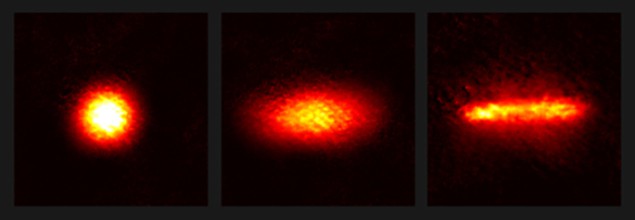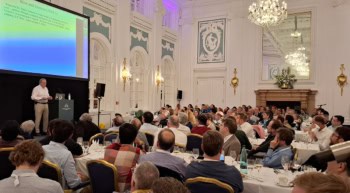
A cloud of cold atoms can be squashed by shining light on it using a new technique developed by Nir Davidson and colleagues at the Weizmann Institute of Science in Israel. The effect was used to flatten spherical clouds of atoms in much the same way that a material can be distorted by an electric field. This optomechanical strain is caused by a force that depends on the density of atoms in the cloud and offers a new way of fine-tuning forces between cold atoms.
For several decades physicists have used two different ways of using light to push, pull and trap atoms. The first involves an atom absorbing and emitting photons at a specific transition frequency – with the momentum of the atom changing in the process. The second involves the atom feeling the force of the electric field associated with a beam of light. The latter is used to create an optical lattice of atoms in a standing wave of light.
Intense pulse
Now, Davidson and colleagues have illuminated a different type of interaction between light and atoms. Their experiments begin with a spherical cloud of about one million cold rubidium-87 atoms. An intense pulse of infrared light with a frequency that is “far detuned” from atomic transitions in rubidium-87 is shone on the cloud. The parameters of the beam are chosen to minimize the force between an individual atom and the electric field of the light.
The cloud acts like a lens and deflects the light. Conservation of momentum means that the atoms feel a force pushing in the opposite direction of the deflection. Nir and colleagues point out that this is a collective force because it acts only on atoms that are in a cloud – and the strength of the force depends on the density profile of the atoms in the cloud. They refer to this effect as electrostriction because the shape changes are similar to those that occur in materials when subjected to an electric field.
Bose–Einstein condensate
The force generated by the light pulse causes the cloud to expand in directions perpendicular to the propagation of the light. This was seen both for ultracold clouds that exist as Bose–Einstein condensates (BECs) and higher-temperature “thermal” clouds. In the case of the BECs, the clouds remained partially condensed even when subjected to relatively intense light pulses.
The team has also developed a theory that successfully explains their observations. Writing in Physical Review Letters, the team concludes “Electrostriction has the potential to be an important tool in cold atom experiments as it effectively induces interparticle interactions, which can be optically tuned”.


